WHY USE TWO HAND CHORDS AND CLUSTERS?
Because they sound great! Two-hand chords and clusters allow you to play voicings on the guitar that would normally be impossible to play. Unless, that is, you have more than one guitarist to work with, or more than five fingers that are abnormally long. And two-hand guitar voicings are done without the percussive ping you get from tapping on the fretboard.
Many beautiful chords are small and harmonically minimal by comparison, but the chords included here are the more lush, rich, thickly voiced kind. That doesn’t mean that they are intended to replace conventional chords, only that they provide a harmonic supplement to traditional guitar chord vocabulary. And they are yours for free!
HOW IT WORKS
Whenever there is an indication to use the same numbered finger in a particular voicing (a need for two 1st fingers in the same chord, for example), use the left hand for the numbers furthest to the left (lower frets, lower pitches) and the right hand for the numbers furthest to the right (higher frets, higher pitches).
Here’s an example:
To play the first of the above F major chord “clusters,” use your left hand to fret the notes on the 1st, 2nd, and 3rd strings. Now press on the 7th fret of the “D” string with the 1st finger of your right hand, and press on the 10th fret of the “A” string with the thumb of your right hand. Then, strum upward with the pinky (4th finger) of your right hand; slowly for a cascading, harp-like effect, quickly for a more traditional chording sound. Be sure to maintain sufficient pressure and finger angles in order to produce a clean sound.
Listen to the first chord cluster of the F major clusters
HEAR “TWO HAND CHORD CLUSTERS” ON YOUTUBE
http://www.youtube.com/watch?v=YnnffA8v6X4
Fingerings for You Tube video “Two Hand Chord Clusters”:
MORE ON FINGERINGS
My fingerings are only suggestions; use whatever fingering makes sense and is comfortable for you. For the right hand fretting, I find that the 1st and 2nd fingers, and the thumb, are the most commonly used. Depress strings with the right hand the same as you normally would do so when using the fingers of your left hand. The letter “T” indicates the use of the thumb of your right hand. The letter “L,” though rarely used, would indicate the use of your lip. You will find it useful to keep the nails on your right hand, including your thumb nail, short in order to get a clean sound.
CHORD LABELS
Chords and clusters are labeled by the highest pitch. For example, the label “9th” next to an A minor chord indicates that the A minor chord is voiced with the 9th, “B,” as the highest pitch. I’ve made no attempt to provide an exhaustive list of chord and cluster possibilities; there’s plenty of room for you to come up with your own voicings. The categories I’ve placed all chords and clusters in follow the scales upon which their pitches are derived.
WHAT IS REQUIRED OF YOU?
Nothing more than curiosity, creativity and a good ear. On the other hand, knowing a little about jazz chord voicings, voice leading, chord progressions, chord embellishments and alterations, and intervals might also prove useful. Good luck and good music!
Steve Montgomery – Summer of 2011
CONTACT ME
Sharing your comments, questions and personal applications is greatly appreciated.
FEEDBACK
Mr. Scofield,
In 1982 when I was 19, I showed you a couple of pieces I had written for two hand chording. For the final bass note in one of the tunes I used my lip while fretting with both hands. I thought you might be interested in the site I’m currently putting up on the topic of playing guitar chords with two hands. It includes thumbnails of chords and chord clusters that require the use of both hands fretting at the same time. It also includes some explanatory text and some audio samples of me using the technique on some of my arrangements and originals. Do you mind visiting the site and letting me know what you think?
Steve Montgomery
Hi Steve
Yes, I remember! . . . 1982, wow . . . time flies. I checked out your website, it’s great! . . . you’ve got me thinking . . . Thanks and good luck with your music!
John Scofield
_______________________________________________
Steve,
I’m delightfully impressed with what you’re doing. The playing is exquisite and your chord-structure is gorgeous. I love “Home.” It is simple and lovely. I also loved “Lulu by Carlight” and “Rainbow,” too. I listened to all of your bites and was really glad to hear what you are doing. I’d love to see you go into the studio and do a really good CD of your playing. I’m also curious about how you tune your guitar. You are doing some really interesting things that require much more than just a typical EADGBE tuning!
Thank you for sharing your amazing creations with me.
Rob Landes
_______________________________________________
Hi Steve,
I like the sound of these chords, but I was having trouble getting the “thumb” note to ring because I have a long thumbnail.
Best,
Ben Monder
_______________________________________________
Hi Steve,
I checked your site, great collection of voicings. Certainly solves the problem of reaching close voicing inversions, not to mention various kinds of clusters. This inspires me to experiment for sure.
Thanks and all the best,
Steve Cardenas
_______________________________________________
Steve,
I love your stuff man…you should put this in book format and sell it…quickly…I’ll be the first to buy a copy. I would like to explore some of these sounds…and find the ones that work for me. Great stuff.
Thanks,
Thaddeus Hogarth
_______________________________________________
Steve,
I got a chance to check out your website. Very intriguing! I really enjoyed listening to the mp3 clips. Many of the voicings have a harp-like quality to them, so I think you’re really onto something. I’d enjoy hearing more mp3 clips of your voicings!
Congrats on the site, and best of luck to you,
Scott Hardy
_______________________________________________
_______________________________________________
Hello Steve,
You have a very unique sound that I enjoy listening to. I’m sure part of it is your technique, but I always believed that those kinds of techniques are born out of musical urges.
Grace and peace be yours in abundance,
Eddie Lewis
_______________________________________________
Hi, Steve.
I checked out your website and was very impressed with your playing and the sounds you get with your two-handed technique. You get some sounds unlike any I’ve heard. I’ll check out more of your site when I get some time and get back to you.
Thanks for getting in touch,
Tom Lippincott
_______________________________________________
Steve,
I read thru your instructions and think they are quite good in explaining. This is a wealth of material as you cover all the chord types. The fact you want to share it with people is both kind and generous.
Byron Atkins
_______________________________________________
Hi Steve,
_______________________________________________
Your voicings are very interesting. I haven’t heard anything like it before. Sounds great, inspiring!
Alf Carlsson
_______________________________________________
Wow, thank you Steve for your great blog! Very interesting ideas and beautiful music; well, isn’t that the most important thing after all?
Guelda
_______________________________________________
Hey, Steve —
This looks very nice. It’s understandable — I feel like I could try your instructions and get decent results . . . even for a trumpet player! = )
Nice to hear from you,
Carol Morgan
_______________________________________________
Very interesting to read about your dual-hand technique. I like the “strumming with the pinky” part.
Cheers,
Ilya
_______________________________________________
Steve,
The world needs more marching band music.
Walter
_______________________________________________
Hey Steve,
I took a look at your blog, very nice. Did you come up with the two hand guitar voicings yourself?
In Christ,
Mike
_______________________________________________
Hi Mike,
Thanks for the good feedback. Yeah, I developed the idea on my own in the early 80’s with two seeds to push things along: (1) I was in a jazz big band that was playing some pretty difficult pieces, but since our piano player quit at an inopportune moment, I had to attempt to cover some of his parts. One tune by Thad Jones had a chord that went like this (from top to bottom): F#, D, B, G, F#. This is impossible normally. But then (2) I thought about how Eddie Van Halen was using two hands (tapping and for a different style) and figured maybe I could use both hands to play some of the jazz piano chords and just kept tinkering with it.
Then I went to Boston (the land of Berklee and 10 thousand guitarists) and compiled a bunch of two hand chords and wrote some pieces for the technique. While I was there I met a 20th Century composer, Merton Brown, and interested him in writing a couple of pieces for the technique (they were pretty difficult but also unique, as far as I was aware, for guitar music of the time). Merton was in on the second wave of atonal composers. He roomed with John Cage (!) was buddies with Lou Harrison (the guy that finished some of Charles Ives’ works), studied with Carl Ruggles, was favorably reviewed by Virgil Thompson, and hung out with a host of other movers and shakers of that style and period. Merton wrote a kind of delicate, minimalist atonal music that could fool you into thinking it was tonal. He was clearly influenced by the music of Duke Ellington and George Gershwin. I was very lucky to have known him and proud to have introduced him to the solo works of pianist Art Tatum.
While I was in Boston (still early 80’s) I was introduced to the music of John Scofield and he became my new favorite guitarist, although Jim Hall was a very close second. I went up to Scofield on the break of one of his gigs and told him I’d like to show him how my two hand chording worked and how it was different from what Stanley Jordan was doing. Scofield said sure, come to Berklee the next day and show me what you’re doing. The next day I was real nervous but I played a piece for him that I’d written that used both hands. He said he liked the song and that if I kept at it I might have something in 10 years or so. As a 19 year old this wasn’t very encouraging, but now that I’m 50, I get a kick out of the comment and think it was a good one (both humbling and accurate).
I’ve looked around for someone doing the same thing so that I could trade ideas and learn from them, but I haven’t found anyone so far. I know there are lots of tappers out there, and lots of guys doing excellent stuff with artificial harmonics, but my chords seem a bit different. Some truly great players that have a bag of tricks and that I’d love to sit down with and show them how I do chords (Ted Greene, Alan Holdsworth, Phillip DeGrue, Pat Metheny, Lenny Breau, Phil Keaggy, etc.) are unfortunately also pretty hard to get a hold of.
I really don’t mind whether or not I get a lot of traffic at this blog; my goal is to make the technique available to other guitarists and maybe get some feedback, or maybe get the chance to hear how someone else might apply it. So please tell anyone that you feel might be interested. I understand I’m not the end all, and I’d love to see what others can do with this idea.
Sorry for the excessive amount of self-absorption,
Steve Montgomery
_______________________________________________
MUSIC SAMPLES THAT CAN BE FOUND AFTER THE CHORD AND CLUSTER FINGERINGS BELOW:
Be
Deep Feelings (intro)
Deep Feelings (solo accompaniment)
Home
Jesus
Breathe
Lulu by Carlight
How He Loves You and Me
Come Home
Travis
Rainbow
There is
Try
Angels
Silent Night
Snow
For Emily
Heart Failure
Star
Walking in a Winter Wonderland
_______________________________________________
DIATONIC BASED CHORDS AND CLUSTERS
Fingerings for G major chords
Listen to G major chords
_______________________________________________
Fingerings for F major clusters
Listen to F major clusters
_______________________________________________
Fingerings for A minor chords
Listen to A minor chords
_______________________________________________
Fingerings for D minor clusters
Listen to D minor clusters
_______________________________________________
Fingerings for D7 chords
Listen to D7 chords
_______________________________________________
Fingerings for F7 clusters
Listen to F7 clusters
_______________________________________________
Fingerings for G major7 b5th chords
Listen to G major7 b5 chords
_______________________________________________
Fingerings for G major7 b5 clusters
Listen to G major7 b5 clusters
_______________________________________________
“JAZZ” MELODIC MINOR BASED CHORDS AND CLUSTERS
Fingerings for A minor major 7th chords
Listen to A minor major 7th chords
_______________________________________________
Fingerings for F minor major 7th clusters
Listen to F minor major 7th clusters
_______________________________________________
Fingerings for Am7b5 chords
Listen to Am7b5 chords
_______________________________________________
Fingerings for Dm7b5 clusters
Listen to Dm7b5 clusters
_______________________________________________
Fingerings for D7 altered chords (dominant 7th chords based on the “jazz” melodic minor scale that include a b5th, #5th, b9th, and #9th)
Listen to D7 altered chords
_______________________________________________
Fingerings for E7 altered clusters (dominant 7th chords based on the “jazz” melodic minor scale that include a b5th, #5th, b9th, and #9th)
Listen to E7 altered clusters
_______________________________________________
Fingerings for D7 “nonaltered” chords (dominant 7th chords based on the “jazz” melodic minor scale which include a b5th)
Listen to D7 nonaltered chords
_______________________________________________
Fingerings for Bb7 nonaltered clusters (dominant 7th clusters based on the “jazz” melodic minor scale which include a b5th)
Listen to Bb7 nonaltered clusters
_______________________________________________
Fingerings for Ab major#5 chords
Listen to Ab major#5 chords
_______________________________________________
Fingerings for Ab major#5 clusters
Listen to Ab major#5 clusters
_______________________________________________
Fingerings for G7sus4b9 chords
Listen to G7sus4b9 chords
_______________________________________________
Fingerings for G7sus4b9 clusters
Listen to G7sus4b9 clusters
_______________________________________________
DIMINISHED BASED CHORDS AND CLUSTERS
Fingerings for G diminished chords
Listen to G diminished chords
______________________________________________
Fingerings for G diminished clusters
Listen to G diminished clusters
_______________________________________________
Fingerings for C13b9 chords
Listen to C13b9 chords
_______________________________________________
Fingerings for F13b9 clusters
Listen to F13b9 clusters
_______________________________________________
APPLICATIONS
Fingerings for chord applications
Listen to Chord applications
_______________________________________________
Fingerings for cluster applications
Listen to Cluster application 1
Listen to Cluster application 2
Listen to Cluster application 3
_______________________________________________
CHORD COMBINATIONS
Fingerings for G major and A minor chord combinations:
Listen to G major and A minor chords
_______________________________________________
Fingerings for G major and D7 altered chord combinations:
Listen to G major and D7 altered chords
_______________________________________________
Fingerings for G major and D7 nonaltered chord combinations:
Listen to G major and D7 nonaltered chords
_______________________________________________
ORIGINALS AND ARRANGEMENTS
BE
“Be” was written for the birth of my son, Stephen. The first chord is a dissonant “B”; the last chord is a consonant “B.”
Fingerings for “Be” by Steve Montgomery:
Here’s “Be” written out on the staff:
Listen to Be
_______________________________________________
DEEP FEELINGS (intro)
“Deep Feelings” was written for my wife. The two-hand chord clusters are easy to hear in both the intro and in the accompaniment for the guitar solo.
Fingerings for the intro of “Deep Feelings” by Steve Montgomery:
Listen to the intro to Deep Feelings
DEEP FEELINGS (solo accompaniment)
The changes to the solo section are the same as with the “head,” which is not included here. There is a quote from the beginning of “The Rite of Spring” by Stravinsky.
Fingerings for the solo section of “Deep Feelings” by Steve Montgomery:
Listen to the accompaniment for the solo section of Deep Feelings
_______________________________________________
HOME
“Home” was written with the Prodigal Son in mind; the departure, the return, and the acceptance. Thanks to Kevin Moody for a great job of sight singing the vocal part.
Fingerings for “Home” by Steve Montgomery:
Here’s “Home” written out on the staff:
Listen to Home
_______________________________________________
JESUS
“Jesus” (“Jesus Loves me this I Know”) was intended for female voice, but Kevin Moody did a great job of sight-reading my arrangement and filling in for me.
Fingerings for “Jesus” by Steve Montgomery:
Here’s “Jesus” written out on the staff:
Listen to Jesus
_______________________________________________
BREATHE
This is my arrangement of the old Church Hymn “Breathe on me Breath of God,” with Kevin Moody sight singing the vocal part.
Here’s “Breathe” written out on the staff:
Listen to Breathe
_______________________________________________
LULU BY CARLIGHT
“Lulu by Carlight” is a combination of bits and pieces taken from “Lulu” by Alban Berg (one of Arnold Schoenberg’s students), the jazz standard “Stella by Starlight,” and some of my own ideas.
Here’s “Lulu by Carlight” written out on the staff:
Listen to Lulu by Carlight
_______________________________________________
OH, HOW HE LOVES YOU AND ME
This is the intro to an old Gospel tune that I’ve revamped a bit. It provides an easily recognizable example of two hand voicings.
Listen to Oh, How He Loves You and Me
_______________________________________________
COME HOME
“Come Home” is my take on another old Gospel tune that I’ve tinkered with a bit. It gives a clear example of two hand guitar voicings.
Listen to Come Home
_______________________________________________
TRAVIS
Travis is an original I wrote in memory of the late great Merle Travis. It has two hand guitar voicings sprinkled throughout.
Fingerings for “Travis” by Steve Montgomery:
Listen to Travis
_______________________________________________
RAINBOW
As you can hear, the chords at the beginning of my arrangement are conventional, but they change into two hand voicings when the melody starts.
Listen to Rainbow
_______________________________________________
THERE IS
This is my combination of “There is a Savior” as performed by Sandi Patty, and “Dancing Queen” by ABBA. For most of it I used conventional guitar chords, but the intro has a few good examples of two hand guitar voicings.
Listen to There is
_______________________________________________
TRY
For this tune, I just put together a repeating set of two hand voicings, and then improvised the melody on top.
Fingerings for “Try” by Steve Montgomery:
Listen to Try
_______________________________________________
ANGELS
I wrote this as a simple exercise to showcase a couple of two hand chord clusters I had recently discovered. A few overdubs assisted things in this case.
Listen to Angels
_______________________________________________
SILENT NIGHT
For this traditional Christmas song I used two hand chord clusters for the accompaniment to the guitar solo.
Fingerings for “Silent Night”:
Listen to Silent Night
_______________________________________________
SNOW
This is a quick study for two hand voicings based on Claude Thornhill’s “Snowfall.”
Fingerings for “Snow” by Steve Montgomery:
Here’s “Snow” written out on the staff:
Listen to Snow
_______________________________________________
FOR EMILY
After explaining my two hand guitar technique to Emily Remler, she suggested I make a recording and send it to her New York address. I put together a short chord study entitled “For Emily,” which quotes “Emily,” “One Less Bell to Answer,” and “A Time for Love.” I then sent it to her for comments and suggestions. About a month later I learned of her unfortunate overdose and untimely death.
Fingerings for “For Emily” by Steve Montgomery:
Here’s “For Emily” written out on the staff:
Listen to For Emily
_______________________________________________
HEART FAILURE
I wrote this with spiritual, rather than physical, failure in mind.
Fingerings for “Heart Failure” by Steve Montgomery:
Here’s “Heart Failure” written out on the staff:
Listen to Heart Failure
_______________________________________________
STAR
I put this together as a chord study based on the introductory “verse” to “Stardust.”
Fingerings for “Star” by Steve Montgomery:
Here’s “Star” written out on the staff:
Listen to Star
_______________________________________________
WALKING IN A WINTER WONDERLAND
For this tune I played the bass part to “All Blue” by Miles Davis and then overdubbed the guitar parts. I used two hand voicings briefly in the background of the intro, and then again for the first 16 bars of the guitar solo.
Fingerings for “Walking in a Winter Wonderland”:
Listen to Walking in a Winter Wonderland
_______________________________________________
BLANK FRETBOARDS






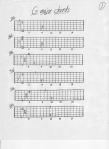




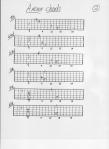



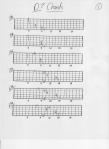




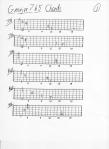







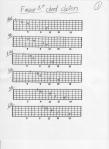





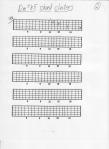













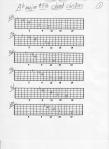






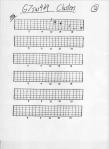





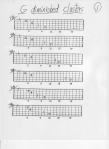


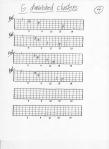











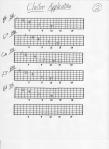

















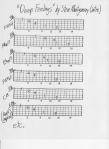



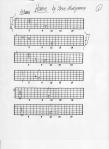











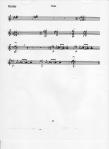


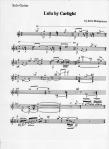

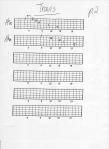










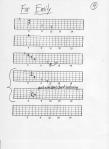









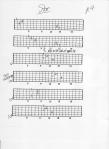


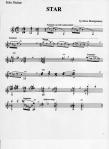



Hi, this is a comment.
To delete a comment, just log in, and view the posts’ comments, there you will have the option to edit or delete them.